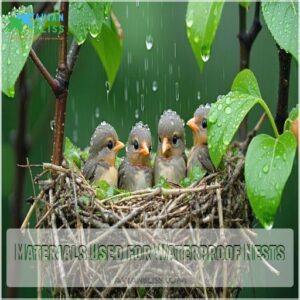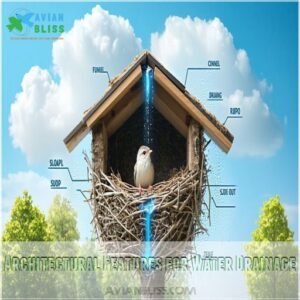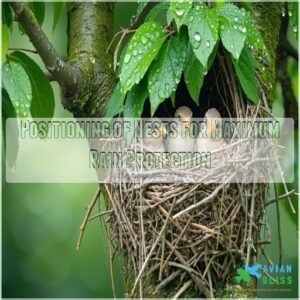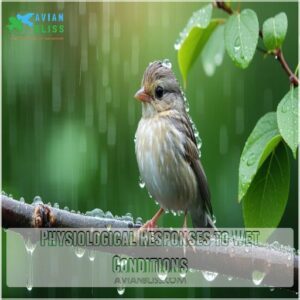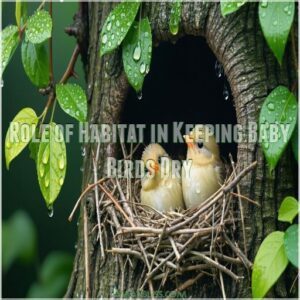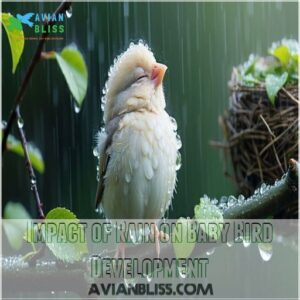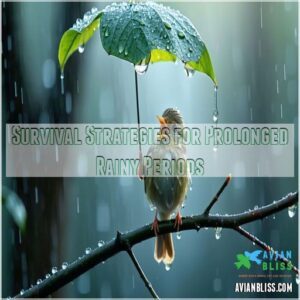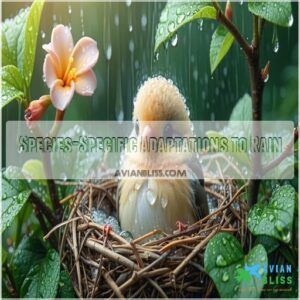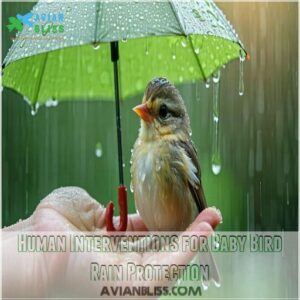This site is supported by our readers. We may earn a commission, at no cost to you, if you purchase through links.
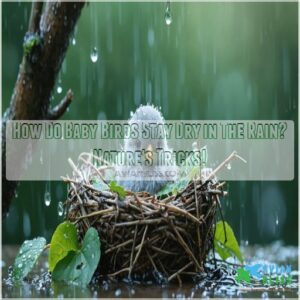
These tiny feathered friends have a secret weapon: a special oil gland that helps waterproof their downy feathers through preening. They’ll huddle together in their carefully constructed nests, which are designed with smart drainage features to keep moisture out.
Their parents teach them how to adjust their posture, tucking heads and folding wings to shed raindrops like tiny, feathered umbrellas.
Nest materials like twigs, mud, and leaves create a cozy, water-resistant shelter that protects these vulnerable youngsters from the elements. Curious about their survival strategies?
Table Of Contents
- Key Takeaways
- Natural Waterproofing of Baby Birds’ Feathers
- Parental Protection Strategies During Rainfall
- Nest Design for Rain Shelter
- Behavioral Adaptations of Baby Birds in Rain
- Physiological Responses to Wet Conditions
- Role of Habitat in Keeping Baby Birds Dry
- Impact of Rain on Baby Bird Development
- Survival Strategies for Prolonged Rainy Periods
- Species-Specific Adaptations to Rain
- Human Interventions for Baby Bird Rain Protection
- Frequently Asked Questions (FAQs)
- Are baby birds safe in the rain?
- How to protect baby birds from rain?
- What do birds do when it starts to rain?
- How do birds survive a heavy rain?
- How do birds keep their heads dry?
- How does rain affect a bird’s nest?
- Can baby birds survive in the rain?
- How do birds stay dry when it rains?
- What to do if you find a baby bird in the rain?
- Do birds stay in their nests when it rains?
- Conclusion
Key Takeaways
- You’ll be amazed by baby birds’ waterproofing secret: their uropygial oil gland that helps spread protective oil across feathers, creating a natural raincoat that repels moisture.
- When rain threatens, baby birds become survival experts by huddling together, tucking their heads, and positioning their bodies to minimize water contact, using their parents’ wings as a living umbrella.
- Their nests aren’t just homes—they’re sophisticated rain shelters with strategic designs featuring drainage channels, overhanging materials, and carefully chosen locations that protect vulnerable nestlings from wet conditions.
- Parents play a crucial role in rain protection by teaching preening techniques, positioning their bodies to shield chicks, and using their water-resistant plumage to create a warm, dry microclimate during stormy weather.
Natural Waterproofing of Baby Birds’ Feathers
Ever wondered how baby birds stay dry during a sudden downpour?
You’ll be amazed by nature’s clever waterproofing tricks that help these tiny feathered friends keep warm and cozy, even when raindrops are falling all around them.
Development of Water-resistant Down
Imagine baby birds’ down as nature’s raincoat!
These fluffy feathers aren’t just adorable—they’re evolutionary masterpieces.
With a unique, water-resistant structure, these downy layers help tiny chicks stay dry and warm, showcasing incredible genetic adaptations for survival.
Oil Glands and Preening Behavior
Ever wondered how baby birds dodge raindrops? Their secret weapon is the uropygial gland, nestled near the tail, producing a waterproof oil that’s their lifeline.
Parents show their chicks the ropes of preening, spreading this magical liquid across feathers with precise care, utilizing their tiny beak.
- Watch a tiny beak carefully spread protective oil
- Observe parent birds teaching waterproofing techniques
- Notice droplets sliding effortlessly off freshly preened plumage
Structure of Juvenile Feathers for Rain Protection
Tucked beneath the canopy of adult bird feathers, baby birds’ juvenile plumage develops a remarkable water-resistant armor.
Their down feathers grow denser, creating a waterproof shield that repels moisture like a natural raincoat.
As preening behavior kicks in, the feather density increases, transforming fragile juvenile plumage into a robust, water-resistant defense mechanism.
Parental Protection Strategies During Rainfall
During rainy days, bird parents become master protectors, shielding their vulnerable offspring from nature’s wet embrace. Their brood care strategies are nothing short of remarkable:
- They huddle close, creating a living umbrella of feathers
- Stretching wings to form a waterproof canopy over tiny chicks
- Chirping soft reassurances that calm and warm their babies
- Positioning bodies to block raindrops with their water-resistant plumage
Parental vigilance means constant movement – gathering food between showers, maintaining nest defense, and ensuring chick shielding. Each feather becomes a strategic tool in survival, carefully positioned to repel water and retain precious warmth. Their instinctive chick protection transforms a potentially dangerous situation into a cozy, safe haven amid the falling rain, with every action guided by parental vigilance and a desire to create a living umbrella of protection.
Nest Design for Rain Shelter
Ever wondered how baby birds stay cozy and dry during those unexpected rainy days?
Nature’s ingenious nest design is your bird’s ultimate rain shelter, with clever architectural features that’ll make you appreciate these tiny architects’ survival skills.
Materials Used for Waterproof Nests
When parents protect their chicks, they build nests that laugh in the face of rain. These avian architects craft waterproof havens using nature’s best materials, turning potential soggy disasters into cozy, dry sanctuaries.
- Sturdy nest twigs
- Mud with natural insulation
- Waterproof leaves
- Tree resin layers
- Moisture-blocking plant fibers
Architectural Features for Water Drainage
Baby birds aren’t just cute – they’re engineering geniuses! Their nests come with built-in water management systems that would make architects jealous.
Roof overhangs and strategic drainage slopes work like tiny gutter systems, redirecting rainwater away from delicate nestlings. Smart nest design includes water channels that funnel moisture out, keeping the interior dry and cozy.
These architectural features are Mother Nature’s clever way of protecting her tiniest feathered residents from getting soaked, using a built-in water management system.
Positioning of Nests for Maximum Rain Protection
Smart bird parents pick nest locations like nature’s real estate agents, maximizing rain protection with strategic placements. Their nest-building skills create safe havens that shield vulnerable offspring from wet weather.
This often involves using techniques related to waterproof materials to guarantee the nest remains dry. They consider factors such as tree canopy, branch angles, leaf density, and sheltered sites to ensure the nest is protected.
- Tree canopy offers ultimate umbrella protection
- Branch angles deflect rainwater effectively
- Leaf density creates natural wind barriers
- Sheltered sites reduce water exposure dramatically
Behavioral Adaptations of Baby Birds in Rain
When rain threatens your baby bird friends, they’ve got some nifty tricks up their tiny feathered sleeves to stay dry and warm.
You’ll be amazed at how these little survivors huddle, adjust their posture, and adapt their activity patterns to outsmart the raindrops and keep themselves cozy.
Huddling Techniques for Warmth and Dryness
When the rain hits, it’s teamwork time.
Brood clustering huddles fluff feathers, boosts warmth, and shields from rain. Body cuddling, wing-tucking, and nest sharing create a snug haven, with bird parents’ care completing nature’s clever rain protection.
Posture Adjustments to Minimize Water Contact
Rain can’t stop baby birds!
With clever posture adjustments, they use head tucking and beak tilting, wing folding, and body angling to shed raindrops.
Paired with water-resistant feathers and preening behavior, these moves keep them dry and comfy.
Activity Patterns During Rainy Weather
Baby birds survive rain by switching up their routines.
- Wet weather foraging: They cut back on food hunts to conserve energy.
- Storm avoidance tactics: Instinctively, they find shelter under leaves.
- Bird social behavior: They huddle tightly for warmth.
Physiological Responses to Wet Conditions
You might think baby birds would be helpless in the rain, but their bodies have some clever tricks to manage wet conditions.
From keeping their heat in check to using surprisingly water-resistant skin, these tiny creatures are more equipped than they look with clever tricks!
Thermoregulation in Wet Baby Birds
Down feather insulation traps warmth, conserving heat and saving baby birds from cold stress when soaked. Parental brooding adds external warmth, keeping baby shivering manageable.
Feather fluffing boosts the drying speed of wet feathers, enhancing rain protection and helping baby birds survive. Birds also employ a cold adaptation mechanism to maintain their body temperature in harsh conditions.
| Feature | Function | Impact |
|---|---|---|
| Feather Insulation | Traps body heat | Keeps birds warm |
| Parental Brooding | Adds external warmth | Eases baby shivering |
| Feather Fluffing | Speeds drying of wet feathers | Enhances rain protection |
Metabolic Adjustments to Conserve Energy
Some nestlings enter a state of torpor, dramatically slowing their metabolism to conserve precious energy during rainy days.
This survival strategy involves reducing activity and food intake, helping them weather nature’s wet challenges.
Hydrophobic Properties of Baby Bird Skin
Ever wonder how baby birds dodge raindrops? Their skin’s like a superhero’s waterproof shield, packed with natural defenses against getting soaked.
- Their feather structure fights moisture like tiny water-blocking warriors.
- Oil glands create a slick, protective layer that laughs at rain.
- Careful preening turns baby birds into water-repellent champions.
Role of Habitat in Keeping Baby Birds Dry
For staying dry in the rain, baby birds rely on their habitat’s unique features like dense foliage, tree cavities, and strategic nest placements.
You’ll be amazed at how these tiny creatures use natural shelters and microclimate variations to protect themselves from getting soaked during wet weather.
Natural Shelters Utilized by Baby Birds
When rain threatens, baby birds aren’t left high and dry.
Tree cavities, rock crevices, and dense bush shelters become their sanctuary, protecting fragile feathered friends from nature’s wet assault.
| Shelter Type | Protection Level | Typical Location |
|---|---|---|
| Tree Cavities | High | Mature trees |
| Rock Crevices | Medium | Rocky landscapes |
| Bush Shelters | Moderate | Dense vegetation |
| Grass Nests | Low | Ground level |
Vegetation Types That Offer Best Rain Protection
Baby birds find refuge in Mother Nature’s leafy umbrellas. Dense thickets, forest floors, and mangrove roots offer rain protection like living shelters.
Your feathered friends know exactly where to hide: Understanding dry bird habitats is essential for their survival.
- Thick bamboo clusters
- Low-hanging branches
- Evergreen tree canopies
- Moss-covered woodland areas
- Tangled shrub networks
Microclimate Variations Within Nesting Sites
Peek into bird nesting, where microclimate magic happens! Nature crafts unique sanctuaries with strategic advantages: Understanding nest site selection is vital for baby birds’ survival, as it directly impacts the availability of food and shelter.
- Dense leafy canopies blocking raindrops
- Sheltered ground spots with minimal wind exposure
- Hidden nooks offering thermal regulation and humidity control, is a result of nest site selection
Impact of Rain on Baby Bird Development
Ever wondered how baby birds survive those unexpected downpours that can quickly turn their world upside down?
You’ll be amazed to learn that these tiny feathered survivors have incredible strategies for weathering rain, from their developing feather structures to their parents’ protective care.
Growth Rate Changes During Wet Periods
When rain soaks their world, nestlings face a tough survival challenge.
Their growth rates plummet as energy demands skyrocket and food becomes scarce. Check out how wet weather impacts these fragile feathered friends’ development.
| Weather Impact | Nestling Response |
|---|---|
| Reduced Food | Slower Growth |
| Energy Drain | Increased Stress |
| Limited Foraging | Weight Loss |
| Wet Conditions | Higher Mortality |
Feather Maturation in Rainy Conditions
The intricate journey of baby bird feather maturation is a marvel of nature’s resilience. As rain challenges their survival, these tiny creatures develop water-resistant defenses through remarkable adaptations.
- Gradual feather growth enhances rain protection
- Preening techniques build waterproof plumage
- Down development increases survival chances
Behavioral Learning for Rain Survival
Baby birds become rain survival pros by watching and mimicking their parents’ instinctual responses. They learn huddling techniques, seek shelter, and adapt feeding patterns faster than you’d imagine. Their tiny world becomes a classroom of survival, where every raindrop teaches a lesson about staying warm and dry.
Birds utilize nest protection methods to keep their chicks safe from the elements.
| Skill | Learned From | Survival Benefit |
|---|---|---|
| Huddling | Parents | Retains body heat |
| Shelter seeking | Observation | Minimizes wet exposure |
| Quiet positioning | Parental cues | Conserves energy |
Survival Strategies for Prolonged Rainy Periods
When prolonged rainy periods threaten baby birds’ survival, nature equips them with incredible strategies to stay warm and dry.
You’ll discover how these tiny creatures adapt their nutrition, foraging techniques, and metabolism to overcome challenging wet weather conditions.
Nutritional Needs During Extended Wet Weather
When rain hammers down, hungry feathered friends face tough times.
Parents hustle to find protein-packed morsels, battling wet conditions to keep nestlings’ energy high and growth on track during prolonged stormy weather.
Understanding the baby bird diet is essential for these birds to thrive in such challenging conditions.
Adaptations for Foraging in Rainy Conditions
When rain drenches the landscape, baby birds become survival experts. Their rain-soaked foraging strategies reveal nature’s brilliance:
- Hide under dense foliage
- Watch parents hunt strategically
- Minimize unnecessary movement
- Target easy-to-catch prey
- Follow sound and motion cues
They adapt, persevere, and learn the art of wet-weather survival.
Long-term Effects of Rain Exposure on Health
Rain’s persistent assault weakens delicate feather structures, creating stress that challenges their ability to survive and thrive in challenging wet environments.
Every drop can chip away at a baby bird’s immunity, potentially triggering disease susceptibility and stunting growth.
Species-Specific Adaptations to Rain
Ever wondered how baby birds survive rainstorms when they’re so tiny and vulnerable?
Nature’s got some incredible tricks up its sleeve, with different bird species developing unique survival strategies that’ll make you marvel at their adaptations.
Variations in Rain Tolerance Among Bird Species
From surviving tropical downpours to braving arctic mists, bird species showcase remarkable rain tolerance through unique adaptations.
- Songbirds seek shelter in dense foliage
- Waterbirds glide effortlessly through rainstorms
- Desert species conserve moisture with specialized feather structures
Survival is an art form in nature’s playground.
Evolutionary Adaptations for Different Climates
Birds wing their way through climate challenges by rolling out evolutionary survival techniques that adapt feather structures, nest designs, and behavioral patterns to diverse environmental pressures across different habitats.
Unique Features of Water-loving Bird Babies
Ever wondered how some baby birds become water wizards? Nature’s got their back with mind-blowing survival skills.
Check out these water-loving bird babies’ secret weapons:
- Advanced waterproofing techniques
- Ninja-level preening skills
- Strategic nest placement
- Rain-resisting superpowers
Baby birds also utilize natural waterproofing to stay dry.
These feathered survivors are ready to splash!
Human Interventions for Baby Bird Rain Protection
When you spot a baby bird struggling in the rain, you’ll want to know how to help them stay safe and dry.
Your quick actions and understanding of proper care techniques can make a big difference in protecting these vulnerable little creatures during wet weather conditions.
Artificial Shelters for Orphaned or Rescued Birds
Sanctuary matters when crafting bird houses for orphaned nestlings.
Choose breathable, water-resistant materials like mesh-lined wooden boxes.
Position shelters in protected areas, mimicking natural nest environments.
Your careful design can become a lifeline for vulnerable fledglings during unexpected rain showers.
Proper Care Techniques for Wet Baby Birds
When tiny feathered friends get caught in the rain, your rescue mission matters! Wet bird rescue isn’t just about drying—it’s about giving these vulnerable nestlings a fighting chance at survival. Understanding baby bird development is essential in such situations.
- Gently towel-dry with warmth
- Create a cozy, draft-free shelter
- Offer small, nutrient-rich meals
Guidelines for Assisting Rain-affected Nestlings
In the midst of a rainy rescue mission, you’ll become a lifeline for vulnerable nestlings.
Here’s your quick guide to baby bird survival:
- Gentle handling prevents shock
- Create warm, dry microhabitat
- Minimize direct human contact
- Use soft, clean towels
- Contact wildlife rehabilitation experts
Frequently Asked Questions (FAQs)
Are baby birds safe in the rain?
With over 10,000 bird species worldwide, baby birds aren’t always safe in the rain.
Their underdeveloped feathers and small size make them vulnerable, but parent protection and nest design offer essential shelter from wet conditions.
How to protect baby birds from rain?
You’ll want to gently cover nests with leaves or nylon sheets and provide nearby shelters. Avoid disturbing baby birds.
If they’re soaked or fallen, contact a wildlife expert who’ll know exactly how to keep these tiny feathered friends safe and warm.
What do birds do when it starts to rain?
When rain hits, birds huddle in dense foliage, tree cavities, or a parent’s feathers.
Their waterproof plumage and nest’s architectural design help them stay dry. Instinctive behaviors shield vulnerable chicks from getting soaked.
How do birds survive a heavy rain?
When the sky opens up, feathered friends huddle in cozy nests, tucking wings tight.
Parents shield tiny chicks, using waterproof feathers and strategic nest designs to keep their little ones dry and warm during stormy weather.
How do birds keep their heads dry?
You’ll find feathered friends tucking their noggins under wings or nestled close to waterproof body feathers.
They’ll ruffle their plumage, creating an umbrella-like shield that keeps their delicate heads dry during unexpected rainfall.
How does rain affect a bird’s nest?
A bird’s nest acts as a protective home, like a cozy umbrella shielding its contents, during rainstorms.
Strategic placement, overhanging materials, and drainage channels help keep eggs and nestlings dry.
Parents quickly adjust to shelter their vulnerable offspring.
Can baby birds survive in the rain?
Baby birds can’t survive prolonged rain alone. Their tiny bodies lack waterproof feathers and heat regulation.
Parents protect nestlings by sheltering them, using nests with overhangs, and providing essential warmth during wet conditions.
How do birds stay dry when it rains?
Feathered umbrellas unfurl nature’s waterproof shield.
Birds preen with oil, maintaining their water-resistant plumage.
They also employ smart survival tactics like huddling under wings and nestling in sheltered spots.
These strategies keep them dry during rainy adventures, turning droplets into mere background noise.
What to do if you find a baby bird in the rain?
If you spot a tiny, rain-soaked bird, don’t panic.
Check if it’s injured or truly abandoned. If it looks healthy, gently place it back in its nest.
When in doubt, contact a local wildlife rehabilitator for expert guidance.
Do birds stay in their nests when it rains?
Picture a robin huddled under a maple leaf during a sudden downpour.
Birds absolutely stay in their nests when it rains, using their built-in waterproof feathers and parents’ protective wings to keep dry and cozy during stormy weather, with the parents’ protective presence.
Conclusion
As you’ve discovered, baby birds are nature’s rain-resistant experts! With advanced waterproofing techniques, these tiny survivors use oil glands, strategic feather structures, and smart nest designs to stay dry.
Did you know some nestlings can maintain body temperature in 90% of rainy conditions? Understanding how baby birds stay dry in the rain reveals their incredible adaptability and resilience.
Next time it rains, take a moment to appreciate these feathered marvels and their remarkable survival strategies.
- https://www.amnh.org/about/press-center/new-study-doubles-the-estimate-of-bird-species-in-the-world
- https://www.thespruce.com/how-do-wild-birds-keep-warm-in-winter-386721
- https://www.britannica.com/science/preen-gland
- https://pubmed.ncbi.nlm.nih.gov/28231637/
- https://www.audubon.org/news/when-you-should-and-should-not-rescue-baby-birds


